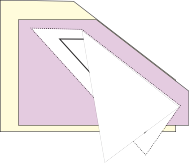Cooler weather means fall fun! Dig out some of your fabric scraps for this adorable pumpkin mini quilt or coaster! If this is the first time paper piecing, I have included those instructions below, and you can click here for the FREE pattern;
Paper Piecing Instructions;
STEP 1: Fold the template on the stitching line
between pieces a and b (Figure 1). Unfold the
template.
STEP 2: Using a piece of fabric large enough to cover piece 1 and the seam allowance around it, place the reverse side of the fabric to the back of the foundation template. Using a piece of fabric large enough to cover piece 2, place it right sides together with fabric a (Figure 2).
To ensure that your piece 2 fabric is in the
correct position, align it while the template is folded. At the least, it should cover the area when folded.
STEP 3: Carefully pick up the fabric and template and move to your machine. Unfold the template and stitch the line between 1 and 2. Start sewing 1/8 inch before the line and stitch 1/8 inch beyond the line.
STEP 4: With the template folded on the line, trim the seam allowance 1/8 inch to 3/8 inch from the folded edge of the template.
STEP 5: Fold fabric the seam and finger press.
STEP 6: Repeat steps 1 through 6 for each
numbered piece working sequentially through the alphabet (e.g., 2/3, 3/4, 4/5).
STEP 7: Gently tear away foundation from the extra stitching in piece 3 to the line between pieces 1 and 2.
STEP 8: Repeat steps 1 through 7 for each lettered piece working sequentially through the numbers (e.g., 1/2, 2/3, 3/4).
STEP 9: Once the piece is completed, trim to the seam allowance.
Repeat for each template.
Joining the Template Pieces:
Using your desired pattern, sew all of your template pieces using the Basic Paper Piecing Instructions listed above.
With right sides together, place a straight pin through the points on the corners on both ends. Use pins or fabric clips along the seam as necessary. If the seam alignment is critical, baste those areas to ensure that your seams align before your final stitching. After joining two template pieces, ensure that they are properly aligned.
Remove the paper from the seam allowance only before adding the next template piece. Complete each block or panel for your pattern.
Join the blocks or panels using the pattern as a guide. Use pins or fabric clips to match critical seam alignments. If your foundation paper is making it difficult to match seams for these panels, remove the paper backing being careful to not stretch the fabric. Otherwise, remove the paper backing after all piecing has been completed.
General Paper Piecing Tips:
Align a piece of card stock on the line you intend to fold. Fold to the card stock. Remove the card stock and crease your fold.
Always overestimate the size of fabric you’ll need for each piece PLUS the seam allowances.
Select a thread that blends with most of your fabrics.
Use an open-front presser foot which allows you to clearly see your stitching.
Set your stitch length to 14 to 18 stitches per inch.
Mistakes happen! Keep a seam ripper handy.
If you’re having difficulty catching the fabric on the feed dogs as you slide it in place to stitch, slip a scrap of paper under the unit being sewn before sliding it under the needle. Tear away the scrap paper after stitching.
For large single pieces and two-piece templates, baste the fabric to the foundation paper across the middle or adhere with a water soluble fabric glue stick. (Remove the basting stitches after your entire quilt has been assembled.)
Trim thread tails after each seam.
Press with a hot, dry iron.
After joining pieces and panels, trim seam allowances that extend beyond the pattern template.
Have tweezers handy to remove small pieces of paper.







Comments
Post a Comment